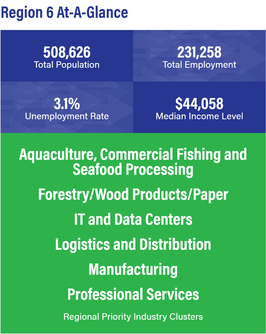Center for Economic and Community Engagement Holds Facilitation in GO Virginia Region 6 to Pinpoint Ways to Grow the Workforce
September 23, 2021

In a series of discussions with stakeholders from a variety of organizations including business, education, workforce development, and local and state government, staff with the Center for Economic and Community Engagement aimed to identify workforce and talent-specific goals, objectives, and actions to incorporate into GO Virginia Region 6’s Growth and Diversification Plan.
The facilitation was led by Afroze Mohammed, the associate director for Strategic Alliances, Mallory Tuttle, the associate director of the Newport News Center, and Jennifer Morgan, the economic coordinator for the George Washington Regional Commission, GO Virginia Region 6’s support organization.
“We wanted to do this facilitation with Virginia Tech’s Center for Economic and Community Engagement because they are good at looking at things from a policy perspective, and they have strong experience with building programs and assisting communities. As the support organization for GO Virginia’s Region 2, they also have familiarity with the GO Virginia program,” said Morgan.
GO Virginia’s Region 6 includes the George Washington Region, Northern Neck, and the Middle Peninsula localities. The region has a total population of 508,626 and has many high-performing industries including aquaculture, seafood processing, and information technology.
“The region is very diverse in geography and resources, with water-based assets, large military operations, as well as close ties to greater Washington, DC and Hampton Roads. This variation caused stakeholders to consider common challenges across the region as well as unique workforce needs in each area,” noted Mohammed.
The region is also home to a number of higher education institutions including the University of Mary Washington, Germanna Community College, and Rappahannock Community College as well as major employers and facilities such as WestRock and the Virginia Institute of Marine Science.
Participants in the discussions expressed a need for more work-based learning and internships, K-12 career preparation, and soft skills training.
“Those participating in the sessions clearly wanted to make an impact in their localities and had a lot of ideas that could be implemented quickly,” said Tuttle.
Several potential projects ideas were brainstormed during the sessions, including a middle school career exploration that would plan for schools to have a certain number of in-person field trips or video tours of multiple regional employers, as well as a “Dress for Success Day” where students would be able to hone their soft skills through mock interviews and workshops on professional attire and resume writing. Other ideas discussed during the sessions included a high school internship requirement, chamber of commerce-led initiatives, and workforce academies.
Keeping connections between industry and schools strong was also a subject of conversation. Packaging company WestRock, for example, has programs in the school system that let students know about career opportunities, which will help them recruit future employees.
“There is a lot of community spirit in Region 6,” said Mohammed. “They are civic-minded, friendly, and are pulling together for the common good.”
“The meeting brought together people in a meaningful way. It got more people engaged in GO Virginia and made them aware of what the program can do. We want to drive home that it’s not the last time we’re having this conversation and want to keep the momentum going,” said Morgan.


